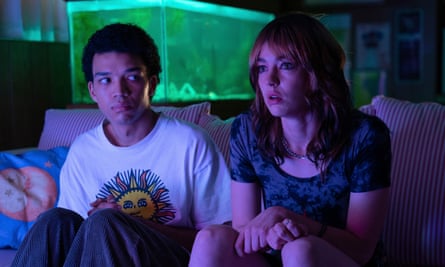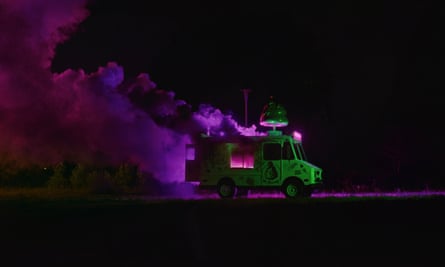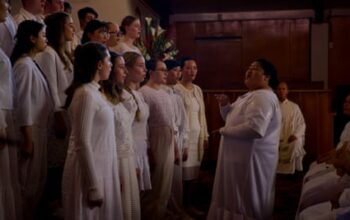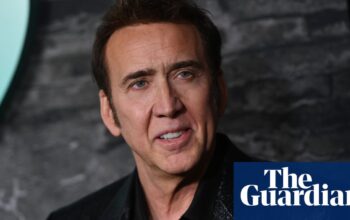For the writer-director Jane Schoenbrun, making their highly anticipated follow-up to the breakout indie horror We’re All Going to the World’s Fair was a starkly different process. While their debut cost about $100,000 to make and felt like the result of 10 people running wild in the woods somewhere, far off the grid, I Saw the TV Glow was something else entirely: a budget larger than anything they had worked with before, a giant machine where everything had to move in careful synchronization.
“It was so different that it was almost like working in a different medium,” Schoenbrun said. “I really tried to take advantage of that with this film. I tried to make something that could be like almost painted. So many images in this film were so labored over.”
Both movies center around queer adolescent outsiders who, to borrow trans parlance, haven’t yet had their eggs cracked. An obsession with certain kinds of media fuels their investigations into their identities, although to say that they are pursuing a queer identity would be a stretch. These are teens who know that something isn’t right, but haven’t even necessarily got far enough to say that it has anything to do with gender or sexuality, much less come out as anything in particular.
Whereas We’re All Going to the World’s Fair interfaced with contemporary social media platforms like YouTube and TikTok, I Saw the TV Glow moves backward in time about 20 years, becoming something of a love letter to the trans kids of the 90s, who mostly didn’t have anything remotely resembling media that was made for them, and so had to rely on discoveries that accidentally, and strangely, resonated with their queerness. The teens at the center of this film find a TV show to latch on to, but then it suddenly gets canceled.
According to Schoenbrun, the idea of teens becoming invested in a canceled TV show can be seen as an allegory for letting go of a straight identity for a queer one. “I realized it was an attempt to talk about how the process of realizing you needed to transition and how starting the transition felt. I had been really fascinated with this idea of a canceled TV show that ends in a terrible unresolved way. And I was obsessed with this idea of characters who were never really able to move on from this unresolved ending of a TV show. The metaphor at the center of the film hinges on something being wrong, almost like an identity or a path being foreclosed in the moment.”
The 90s and 2000s were also a period the resonated with Schoenbrun, who at that time was moving through childhood, still years away from recognizing their trans identity. “My upbringing was solidly pop cultural,” they said. “So many TV shows that the movie is paying homage to, The X-Files, Buffy, Twin Peaks, these were huge parts of my adolescent DNA, as well as Donnie Darko, early Christopher Nolan and Darren Aronofsky films. They were the language that taught me what cinematic storytelling could be.”
Schoenbrun’s films may center queer and trans characters, but they are very far from the mainstream “trans movie”. As they noted, “the classical Hollywood image of trans person, which I think has propagated a lot of falsehoods about the trans experience, is a sad kid looking in a mirror, or someone giving a heartbreaking Oscar-winning speech about how they always knew they were supposed to be a girl.” Instead of promoting an “I always knew” narrative, their films instead center on that feeling of amorphous not-rightness that is a touchstone of the trans experience, and their protagonists struggle for ways of comprehending what that means, and finding even the most basic language for articulating it. It’s a very different version of the trans experience, one that is arguably more bottom-up from within the community than top-down imposed by those who may have reason to want a tidy narrative of coming out and affirmation.

These more tidy versions of the trans experiences were not things that Schoenbrun found relatable. “That’s one of the reasons it took me so long to figure out I was trans, because for me dysphoria was a much more oblique and much more internal experience,” they said. “It was this feeling of unreality, this longing to exist in a liminal, dreamlike space, because the space of the world felt limiting in a way that I didn’t understand at the time wasn’t normal. So the film language that I’m indebted to in my work and that I’m trying to use to express something of my own experience is very much about liminality and body horror and shimmer and the aesthetic of haze.”
In I Saw the TV Glow, Schoenbrun largely establishes this aesthetic through the performance of Justice Smith, whose character, Owen, appears to be working extremely slowly through a decades-long realization of his queer identity. Owen moves through the world at a dreamlike pace, as though out of sync with everyone around him, and he speaks in a strange register that sounds slightly uncanny. It’s no surprise that so much of Owen’s screentime occurs deep in the night, bathed in the otherworldly glow of the TV screen, or else in everyday spaces that, in Schoenbrun’s hands, seem depopulated and decontextualized, making them feel vaguely Lynchian.
Like its predecessor, I Saw the TV Glow does not attempt to deliver a riveting plot as much as follow the logic of emotion, image, free association and the murky movements of our basic desires. For Schoenbrun, their films come together as a mixture of high and low, intention and poetry: “The plots of my films are pretty exhaustively planned, but there are lot of parts that I purposefully don’t overthink, because once it becomes too consciously brainy, it becomes too much like a metaphor or puzzle that you can solve like a math equation. I’m a lover of genre and pop culture, and I think the films are a strange fusion of all these influences. I want to make work that I would have loved at 16, but I think equally the works are suspicious of the concept of peer or commercial entertainment.”
Part of the haze that Owen moves within is created by the strange sense of time in I Saw the TV Glow – the movie starts with Owen as a young boy and ends with him in middle age, yet Schoenbrun’s movement through the years feels subjective, unpredictable and difficult to read. This is not a movie that relies on any objective time register but that instead moves to internal rhythms that Schoenbrun intuits throughout. For Schoenbrun, this is all part of a trans cinematic vocabulary that they are attempting to bring into being.

“The way that time moves in my films, the way that rhythm moves, the way that the films interact with an oneiric perspective, the use of the screen as a way for mediating our identity and image and participating in fictionalization in a fluid process with reality – I think these are all deeply trans things that haven’t necessarily been reclaimed,” they said. “It’s exciting to see that process start to happen and to build a genuine trans vocabulary, because I think that so much of what people do think of as a trans vocabulary in cinema is at best a fallacy and at worst deeply harmful to trans people. This becomes an oversimplification through which we can try to articulate something to a dominant political force. But I don’t want to make movies for the enemy. I want to make movies for my people.”
I Saw the TV Glow is a deeply ambitious film, and one that is very much at odds with the Hollywood machine that saw a star in Schoenbrun and invited them into its world. For as visually beautiful and emotionally rich the movie is, it is also a film that can be alienating to those who might expect a story with more narrative hooks to grab on to, or an audience that might want more of an education in queerness than a submersion into it. Schoenbrun very much sees themselves as a person attempting to push the boundaries of trans film, in an industry that still lacks trans representation and comprehension.
“If there are only a few trans film-makers working in any kind of a space that touches Hollywood, there are even less people on the other side of the table, who are trans,” they said. “There are just not any trans people in any kind of position of power. This is a language barrier, and the things in my films that might appear incorrect or impenetrable to this audience who has the power to give me a green light, are the exact things that are going to resonate to me and my community. And doing that work is crazy.”
-
I Saw the TV Glow is out now in US cinemas and in the UK later this year
Source: theguardian.com


